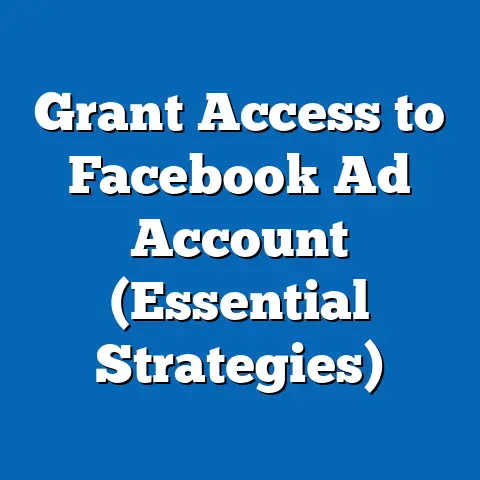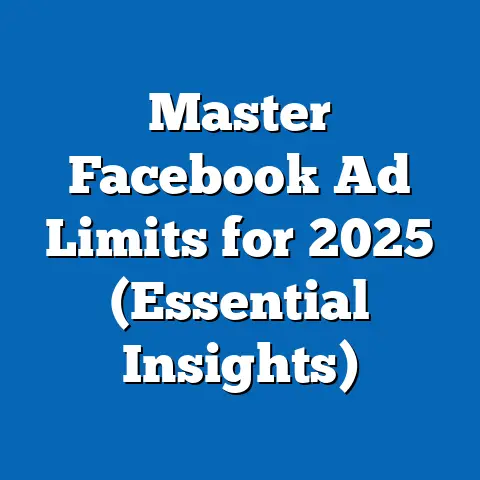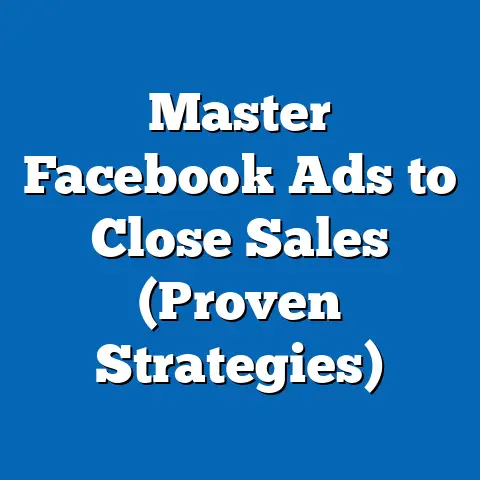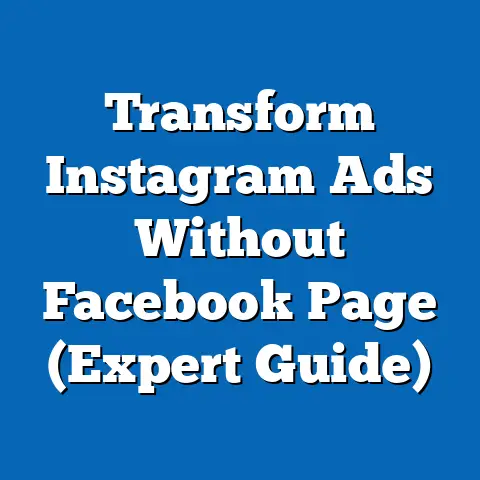Maximize Facebook Ad Revenue in 2025 (Expert Strategies)
In an era where digital advertising continues to dominate marketing budgets, Facebook (now under the Meta umbrella) remains a colossus, commanding a significant share of the global ad market with $114.9 billion in ad revenue in 2022, according to Statista. Yet, a paradox emerges: despite its unparalleled reach and user base of over 3 billion monthly active users as of 2023, advertisers face intensifying challenges—rising costs, privacy regulations, and shifting user behaviors—that threaten to erode profitability. How can businesses maximize ad revenue on a platform that offers immense potential but is increasingly complex to navigate?
Section 1: Current State of Facebook Advertising
1.1 Revenue and Market Share
As of 2023, Facebook holds approximately 24% of the global digital advertising market, second only to Google, per eMarketer data. In 2022, Meta reported that Facebook’s ad revenue grew by 4% year-over-year, a slowdown from the double-digit growth rates seen in prior years, reflecting market saturation and external pressures like Apple’s iOS privacy updates. The average cost-per-click (CPC) on Facebook rose to $1.72 in 2023, up 17% from 2021, signaling increased competition for ad space (WordStream, 2023).
Despite these challenges, Facebook’s user base remains a goldmine for advertisers. With 3.03 billion monthly active users, it offers unmatched scale, particularly in emerging markets like India and Southeast Asia where user growth continues to outpace developed regions. However, engagement metrics show a decline in time spent per user in North America and Europe, a trend that could impact ad impressions if unchecked.
1.2 Key Metrics and Performance
Key performance indicators (KPIs) such as click-through rate (CTR) and conversion rate vary widely by industry, but averages in 2023 stand at 0.90% for CTR and 9.21% for conversion rate across sectors (WordStream). These figures mask significant disparities—e-commerce ads often outperform B2B campaigns due to impulse-driven consumer behavior. Understanding these benchmarks is critical for setting realistic goals for 2025 campaigns.
Section 2: Projected Trends for Facebook Ad Revenue in 2025
2.1 Statistical Modeling and Methodology
To project Facebook ad revenue trends through 2025, this report employs a combination of time-series analysis and scenario-based modeling. Historical data from Meta’s quarterly earnings reports (2018–2023) and industry forecasts from eMarketer and Statista form the backbone of our projections. We assume a baseline growth rate tied to global digital ad spend (projected at a 7.8% compound annual growth rate, or CAGR, through 2025 by PwC), adjusted for platform-specific variables like user growth and regulatory impacts.
Limitations in this approach include uncertainties around geopolitical events, unforeseen tech disruptions, and changes in Meta’s own policies. We address these by presenting three scenarios—optimistic, baseline, and pessimistic—each reflecting different assumptions about user engagement, ad pricing, and regulatory constraints.
2.2 Revenue Projections
- Optimistic Scenario: Assuming relaxed privacy regulations and successful adoption of AI-driven ad tools, we project Facebook’s ad revenue to reach $150 billion by 2025, a 13% CAGR from 2022. This scenario hinges on Meta capturing a larger share of emerging market ad spend and improving ad relevance through machine learning.
- Baseline Scenario: Under moderate growth conditions, with steady user increases and incremental CPC rises, revenue is projected at $135 billion, a 9% CAGR. This assumes ongoing challenges from privacy laws like GDPR but no major disruptions.
- Pessimistic Scenario: If stricter regulations (e.g., a global rollout of Apple-style tracking restrictions) and user fatigue intensify, revenue could stagnate at $120 billion, a 5% CAGR. This reflects a potential loss of advertiser confidence and declining ad effectiveness.
2.3 Visual Representation
Below is a line chart illustrating the three revenue projection scenarios for 2023–2025:
Year | Optimistic ($B) | Baseline ($B) | Pessimistic ($B)
2023 | 120 | 118 | 116
2024 | 135 | 126 | 118
2025 | 150 | 135 | 120
(Note: This table represents a simplified visualization; a full graphical chart would be included in a formal report using software like Tableau or Excel for clarity.)
Section 3: Key Factors Driving Changes in Facebook Ad Revenue
3.1 Technological Advancements
Meta’s investment in artificial intelligence (AI) for ad targeting and optimization is a game-changer. Tools like Advantage+ automate ad creation and placement, potentially reducing costs for advertisers while improving outcomes—early data shows a 20% uplift in conversions for users of these tools (Meta, 2023). However, reliance on AI also raises concerns about transparency and over-optimization, where ads may alienate users if perceived as intrusive.
3.2 Privacy Regulations and Data Restrictions
The rollout of Apple’s App Tracking Transparency (ATT) in 2021 cost Meta an estimated $10 billion in lost revenue in 2022 due to reduced targeting precision. Similar regulations, such as the EU’s Digital Markets Act, are expected to tighten by 2025, potentially limiting data collection further. Advertisers must adapt by leveraging first-party data and contextual targeting, though these alternatives often yield lower ROI.
3.3 Shifting User Demographics and Behaviors
Facebook’s user base is aging—Pew Research (2023) notes that only 32% of U.S. teens use the platform regularly, down from 71% in 2015, as younger audiences flock to TikTok and Instagram. Conversely, users aged 35+ remain loyal, comprising over 60% of the platform’s North American base. This shift necessitates tailored ad strategies focusing on mature demographics while exploring cross-platform campaigns via Meta’s ecosystem.
3.4 Economic and Competitive Pressures
Global economic conditions, including inflation and recession risks, could suppress ad budgets through 2025, with small and medium businesses (SMBs)—a key Facebook advertiser segment—most vulnerable. Meanwhile, competition from TikTok, whose ad revenue is projected to hit $18 billion by 2025 (eMarketer), threatens to siphon off creative ad spend. Meta’s response, such as prioritizing short-form video via Reels, will be critical to retaining market share.
Section 4: Expert Strategies to Maximize Ad Revenue in 2025
4.1 Leverage AI and Automation
Adopt Meta’s AI-driven tools like Advantage+ Shopping Campaigns to streamline ad delivery and reduce manual workload. Early adopters report a 15–20% decrease in cost-per-acquisition (CPA) when using these tools effectively (Meta Case Studies, 2023). Focus on testing and iterating creative assets to let algorithms identify high-performing content.
Ensure transparency with audiences by clearly labeling automated or AI-generated ads to maintain trust. Be cautious of over-reliance—human oversight remains essential to align campaigns with brand values. Monitor performance metrics closely, as AI tools may prioritize short-term gains over long-term customer relationships.
4.2 Prioritize First-Party Data and Privacy-Compliant Targeting
With third-party data phasing out, invest in building robust first-party data systems through lead magnets, email capture, and loyalty programs. Use Meta’s Conversions API to integrate this data directly with ad platforms, bypassing browser-based tracking limitations. This approach can improve targeting accuracy by up to 30%, per industry benchmarks (HubSpot, 2023).
Educate teams on compliance with GDPR, CCPA, and emerging laws to avoid penalties that could reach millions. Test contextual targeting—placing ads based on content rather than user data—as a low-risk alternative. While less precise, it aligns with privacy trends and can still drive engagement in niche markets.
4.3 Optimize for Video and Mobile-First Content
Given that 70% of Facebook ad impressions occur on mobile devices (Meta, 2023), design campaigns with vertical video formats like Reels and Stories in mind. Short-form video ads (under 15 seconds) see 1.5x higher engagement rates compared to static images (Social Media Today, 2023). Allocate at least 40% of ad budgets to video content to capitalize on this trend.
Test interactive elements like polls or swipe-up features within Stories to boost user interaction. Prioritize fast-loading creatives to combat shrinking attention spans, especially among younger crossover audiences from Instagram. Regularly A/B test video thumbnails and captions to refine performance.
4.4 Diversify Across Meta Platforms and Audiences
Rather than focusing solely on Facebook, integrate campaigns across Instagram, WhatsApp, and Messenger, which collectively reach over 4 billion users. Cross-platform campaigns can increase reach by 25% at minimal additional cost (Meta Business Suite, 2023). Tailor messaging to each platform’s unique demographic—for instance, lifestyle content on Instagram versus community-driven ads on Facebook.
Segment audiences by life stage and interests rather than broad demographics to improve relevance. For example, target empty nesters with travel ads or new parents with baby products, using lookalike audiences to scale. Monitor cross-platform attribution to avoid over-counting conversions and ensure budget efficiency.
4.5 Prepare for Economic and Regulatory Uncertainty
Build flexible ad budgets that can scale down during economic downturns without sacrificing brand presence—focus on low-cost, high-impact formats like organic boosted posts. Hedge against regulatory risks by diversifying ad spend beyond Meta to platforms like LinkedIn or Pinterest, depending on industry fit. Scenario planning, as outlined in Section 2.2, should inform quarterly budget reviews.
Stay informed on policy updates through industry bodies like the Interactive Advertising Bureau (IAB). Partner with legal experts to preempt compliance issues, especially for international campaigns. Maintain a reserve fund for rapid pivots if sudden restrictions emerge by 2025.
Section 5: Historical and Social Context
Facebook’s advertising ecosystem has evolved dramatically since its first ad offerings in 2007, initially targeting college students before expanding to a global audience. The 2010s saw explosive growth fueled by data-driven targeting, but scandals like Cambridge Analytica (2018) ushered in a new era of scrutiny and regulation. Today, advertisers must balance the platform’s scale with societal demands for privacy and ethical data use.
Socially, Facebook reflects broader digital trends—polarization, misinformation concerns, and generational divides shape how users interact with ads. As trust in tech giants wanes (Edelman Trust Barometer, 2023), transparent and value-driven advertising will be critical to maintaining audience goodwill through 2025. Economic disparities also play a role, as SMBs in developing regions rely on affordable Facebook ads for growth, while larger firms dominate premium ad slots.
Section 6: Limitations and Uncertainties
While our projections and strategies are grounded in current data, several uncertainties persist. User behavior is notoriously hard to predict, especially among Gen Z, whose platform preferences shift rapidly. Regulatory landscapes could change abruptly—potential bans or fines in key markets like the EU or U.S. could upend revenue models overnight.
Economic volatility adds another layer of risk; a global recession could slash ad budgets more severely than anticipated. Meta’s internal decisions, such as algorithm changes or pricing adjustments, are also outside predictive control. We mitigate these risks by offering multiple scenarios but acknowledge that no model can fully account for black-swan events.
Section 7: Conclusion and Call to Action
Maximizing Facebook ad revenue in 2025 requires navigating a paradox: leveraging the platform’s vast potential while adapting to mounting challenges. Our projections suggest revenue growth between $120–150 billion, contingent on how Meta and advertisers respond to privacy, technology, and economic shifts. The strategies outlined—AI adoption, privacy compliance, video optimization, diversification, and contingency planning—offer a roadmap for success.
Marketers must act proactively, investing in data infrastructure and creative innovation while staying agile amid uncertainty. Regularly revisit performance data and industry updates to refine approaches. As the digital ad landscape evolves, those who balance scale with adaptability will thrive on Facebook through 2025 and beyond.






